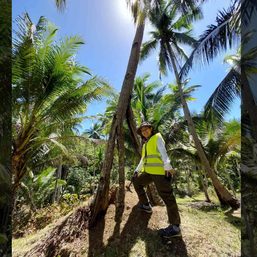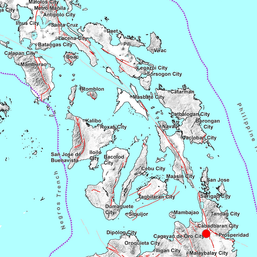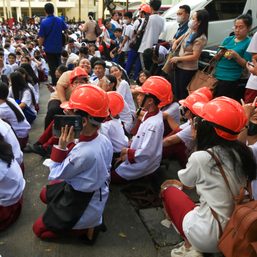SUMMARY
This is AI generated summarization, which may have errors. For context, always refer to the full article.
![[ANALYSIS] Devastating Turkey earthquakes and the theory of stress triggers](https://www.rappler.com/tachyon/2023/02/turkey-earthquakes.jpg)
On February 6, 2012, Negros Island in the central Philippines was struck by a magnitude 6.9 earthquake that devastated the eastern coastal towns of Guihulngan, La Libertad, Jimalalud, Tayasan, and Ayungon, stretching for over 30 kilometers. Infrastructure damage was heavy, including collapsed buildings and bridges and eroded roadways.
As if to commemorate the 11th anniversary of that seismic event but on the other side of the globe, on February 6, 2023, eastern Turkey, near the border with Syria, was struck by not one, but two massive earthquakes, a magnitude-7.8 and a magnitude-7.5 occurring in a span of only about nine hours over a 50-kilometer radius.
About 30 times greater than the Negros 2012 event, the strength of magnitude-7.8 earthquake is the same as that of the devastating July 16, 1990 earthquake of northern Luzon attributed to the movement of the Digdig Fault, a branch of the very active Philippine Fault system. While the epicenter was located in Nueva Ecija, the northern Luzon earthquake inflicted heavy infrastructure damage and deaths over a 100- kilometer radius to as far as Baguio City in Benguet and Dagupan City in Pangasinan. Imagine then the twin Turkish earthquakes occurring in the Philippines, say in Metro Manila (the West Valley Fault is believed to be capable of generating a magnitude-7.5 tremor) and some 100 kilometers away, say in Tarlac City within a day.
The result would be tens of thousands of lives lost in the first three days (the first 72 hours are crucial in disaster response) and countless collapsed infrastructure, fires, power outages and cut-off lifelines. As of this writing, over 15,000 earthquake-related deaths have been reported in Turkey… and counting.
Extrusion tectonics
What is causing the earthquakes in eastern Turkey?
Earthquake scientists attribute the temblors to movement along the East Anatolian Fault, a system of active faults that serves as the boundary between two tectonic plates namely, the Arabian Plate to the southeast and the Anatolian Block to the northwest. Because of plate tectonics, the Arabian Plate, which hosts countries like Syria and Iraq to the north, Israel and Jordan to the west, and Saudi Arabia and Yemen to the south, is pushing northwards and is colliding with Asia to the northeast, and with the Anatolian Block, where Turkey largely sits, to the northwest (the northward motion of the Arabian Plate allows it to split away from Africa, thus the opening of the Red Sea, a section of which is believed to have been “parted” by Moses during biblical times).
As this happens, Turkey is extruded to the west, much like how the face of a boxer would react when hit by a heavy punch from the opponent (think high-resolution slow-motion replay!). In technical terms, scientists call this process “extrusion tectonics,” but others intending to simplify the concept call it “watermelon tectonics,” alluding to what happens to the juicy fruit when it is squeezed between two solid objects.
To complete the westward squeeze of Turkey towards the Mediterranean Sea, another fault needs to slip at the northern edge of the Anatolian Block. This fault is the North Anatolian Fault, a dreaded active fault system since it has been the generator of at least seven devastating earthquakes in the last 100 years. The fault passes close to Istanbul, so like the Californian cities of San Francisco and Los Angeles, and Metro Manila in the Philippines, the Turkish historical capital is likewise waiting for the Big One.

The extruding blocks in Turkey have a mirror equivalent in south and east Asia. As the Indian Plate pushes northwards to collide with Asia to build the Himalayan mountains that host the highest peaks in the world like Mt. Everest, Southern China where cities like Hong Kong and Macau sit, is extruded eastward towards the South China Sea along the Red River Fault to the south and the Altyn Tagh Fault to the north. Though less frequently, these fault systems have generated devastating earthquakes in recent geological times. The historical Vietnamese capital of Hanoi sits along the Red River Fault.
Coulomb stress transfer
Earthquake scientists in recent years have employed the principles of the Coulomb stress transfer (CST) theory to explain the behavior of rupturing faults.
The theory revolves around the idea that the earthquake generated by a slipping fault is a manifestation of the release of stresses that have accumulated on that fault over time. That segment of the fault that slips is thus said to have experienced stress decrease and becomes an unlikely location of the next immediate earthquake.
When seismic stresses are released, however, they do not disappear in thin air but instead transfer to another crustal location. That location where stresses transfer to is said to experience stress increase. If a fault exists in the stress increase region, then that fault is likely to be the next to slip and generate the next earthquake, following a phenomenon called earthquake triggering.
A CST model computed a few days after the two Turkish earthquakes suggests that the magnitude-7.5 event was triggered nine hours later and 100 kilometers away by the magnitude-7.8 earthquake.
In the Philippines, a similar phenomenon was observed between the two earthquakes that struck Abra in northern Luzon in the latter part of 2022. Although the span between earthquakes of about three months is much longer than that separating the Turkish earthquakes, the Abra earthquakes occurred over a much closer spatial distance of less than 20 kilometers. CST modeling of the Abra earthquakes also suggests triggering, albeit over a longer period of time. (Next: Stress triggering in recent PH earthquakes). – Rappler.com
The author, Mario A. Aurelio, PhD, is a professor at the National Institute of Geological Sciences interested in the study of earthquakes. He was part of a team that conducted a study of the Izmit segment of the North Anatolian Fault System (NAFS) after it generated a magnitude-7.6 earthquake in 1999. Photo above shows the author inspecting rows of poplar trees displaced by movement of the Izmit segment of NAFS in northwestern Turkey in 2000.
Add a comment
How does this make you feel?


![[ANALYSIS] Lessons in resilience from Japan’s New Year’s Day earthquake](https://www.rappler.com/tachyon/2024/01/TL-japan-earthquake-warning-system-jan-3-2024.jpg?resize=257%2C257&crop_strategy=attention)


There are no comments yet. Add your comment to start the conversation.